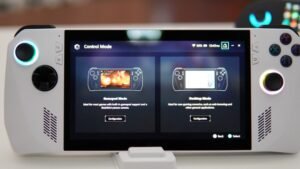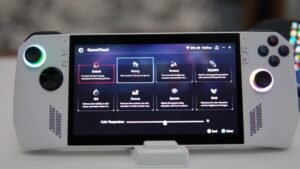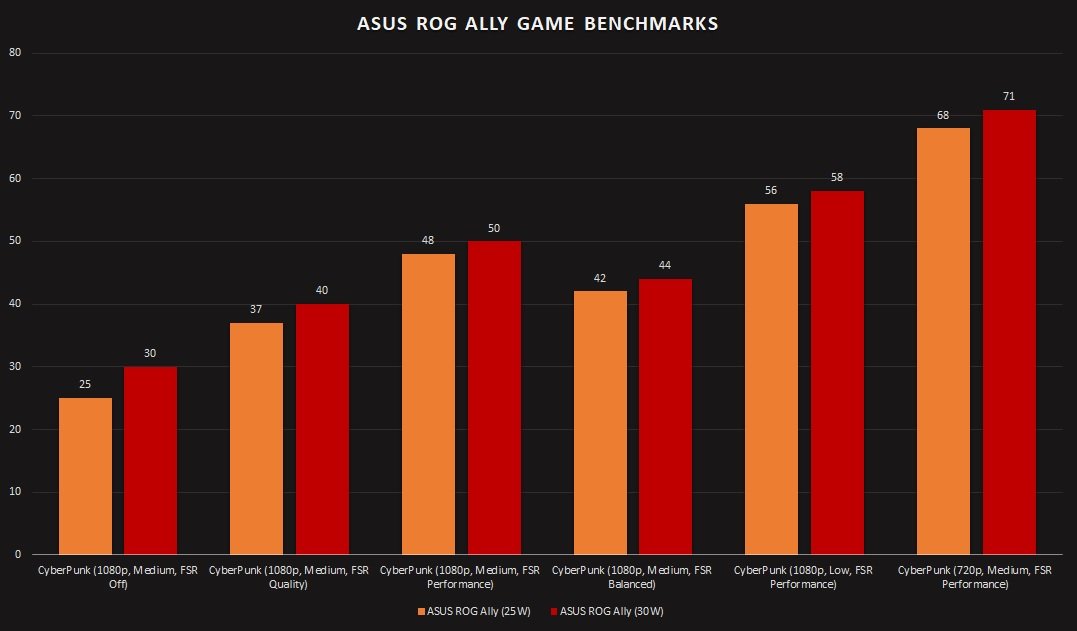What was first thought to be an April Fool’s prank is now a reality as ASUS releases its first dedicated Windows gaming handheld. We got a chance to take the new ASUS ROG Ally for a spin, and here are our thoughts about the new AMD-powered portable gaming PC.
Design
While the PC gaming industry is mainly about gaming laptops, monitors, GPUs, keyboards, etc, there is a dedicated market for Windows gaming handhelds with popular Chinese manufacturers such as Aya Neo, GPD, ONEXPLAYER, AOKZOE, and more. Things did change when Valve entered the competitive market with the affordable Steam Deck that also had better battery life and decent performance.
And here we are now with the new ROG Ally, ASUS’s first handheld to take on the Steam Deck. The design of the device does resemble the looks of the AOKZOE A1, another AMD-powered handheld that was released last year. The ROG Ally features a 7-inch IPS display with 1920 x 1080 as the native screen resolution and 120Hz as the refresh rate. The 120Hz refresh rate is perhaps a first in a Windows gaming handheld and is a killer feature, provided you are able to run that many frames for selective PC games.
 ASUS also mentions that the response time of the display is 7ms. The screen also covers 100% sRGB color space and has a brightness that maxes out to 500 nits. The viewing angles of the IPS panel are great and the screen also has support for AMD FreeSync Premium to eliminate all those screen tearing issues during gaming. The screen panel also features Gorilla Glass Victus for some extra durability against scratches and bumps, along with the addition of Gorilla Glass DXC coating that helps to reduce surface reflections.
ASUS also mentions that the response time of the display is 7ms. The screen also covers 100% sRGB color space and has a brightness that maxes out to 500 nits. The viewing angles of the IPS panel are great and the screen also has support for AMD FreeSync Premium to eliminate all those screen tearing issues during gaming. The screen panel also features Gorilla Glass Victus for some extra durability against scratches and bumps, along with the addition of Gorilla Glass DXC coating that helps to reduce surface reflections.
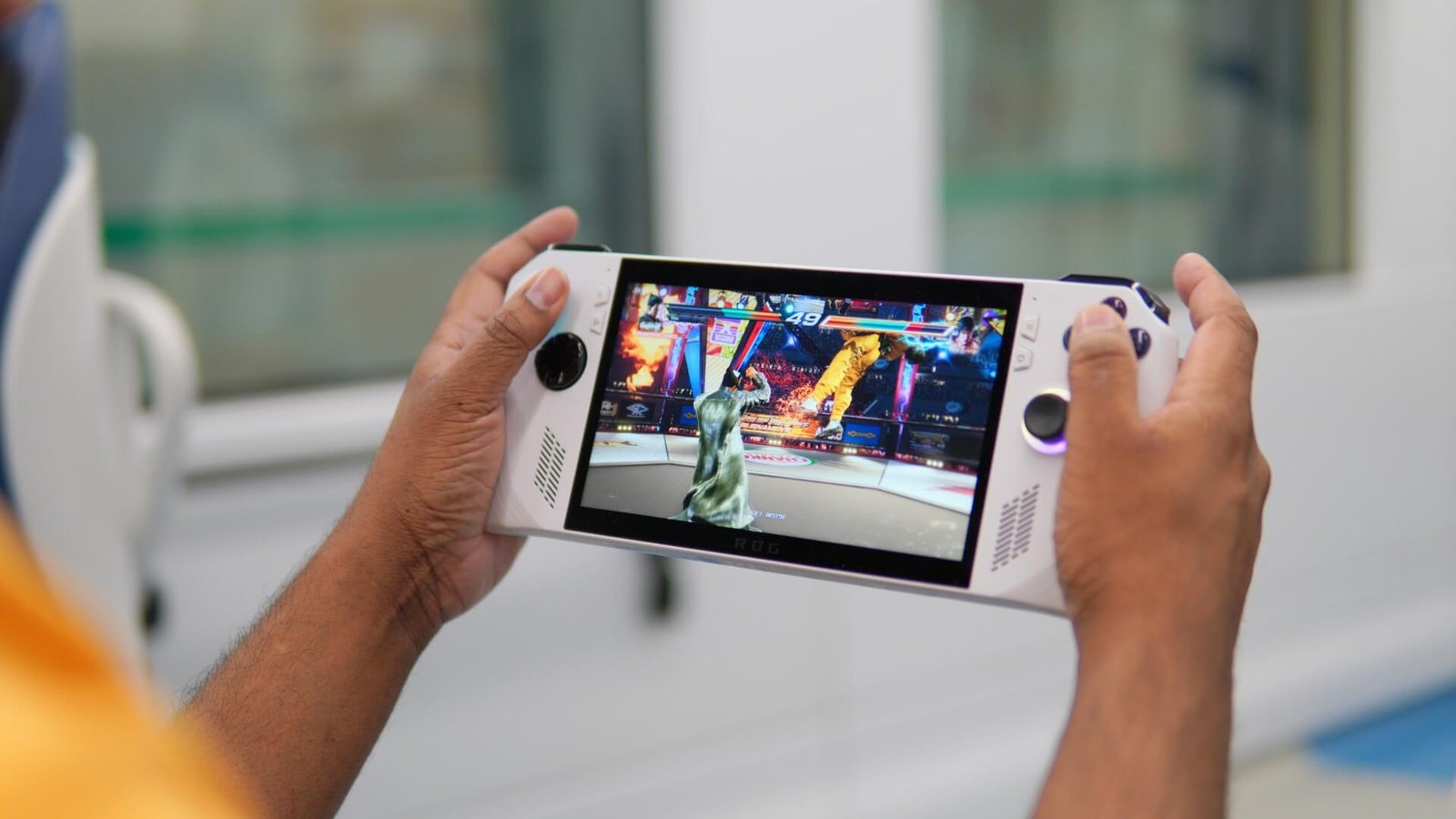
Imagine playing your favorite games with the ASUS ROG Ally while traveling via Dubai Metro.
While the device weighs only 608g, the chassis of the ROG Ally feels very light when holding the console while gaming. I really appreciate how the front-facing button placements are designed in such a way that the user is able to easily reach them with their thumbs. And as you noticed, the chassis’s controller is based on the Xbox’s asymmetrical layout. The front portion of the device is designed in such a way that the palm of your hand can comfortably rest for a stress-free handheld gaming session. And this portion of the chassis also features the ROG decoration lines.

The analog sticks on the left and right are easy to reach and there are also the Aura Sync-based RGB lighting effects that can be customized easily. Along with the black and glossy D-pad buttons on the left, there are two buttons arranged vertically, next to the screen, and these are for the View function and the Command Center button. On the right, there are another two buttons arranged in a similar fashion and are for activating the menu function and the Armoury Crate application. The ABXY buttons are large and easy to use while gaming. There are two front-facing, Dolby Atmos speakers located on either side of the device. The audio quality is crisp and the volume is loud enough, thanks to the built-in Smart Amplifier technology.
Looking from the top side, you have the fingerprint scanner on the left, along with the volume rocker in the middle portion, a couple of LEDs and a USB-C 3.2 Gen2 port (supports data transfers, power connectivity, and DisplayPort 1.4), an interface for ROG XG Mobile connectivity, a microSD UHS-II-based card reader, and the 3.5mm audio jack on the right side. While the ROG XG Mobile interface brings more connectivity options, I wish ASUS had added a couple of more USB-C ports since the bottom of the device has no ports or buttons at all. I came across situations where when copying over heavy games, the Ally was running out of battery power, and I had no choice but to cancel the transfer and charge the device. A second USB-C port could have been convenient in this situation.

The ROG Ally features a dual-fan design to increase the effectiveness of cooling and this allows for a quieter fan operation while gaming- and they weren’t kidding. During my time with the device, the fans were barely audible while playing graphic-intensive games. ASUS also has included their new anti-gravity heat pipes that are designed to offer efficient cooling and heat transfer, even when the device is inverted. As a part of the cooling system, the top side also has two exhaust air vents placed on either side. The vents meant for air intake are located on the rear side of the chassis. ASUS designed the rear-facing air intake vents in the form of parallel lines on the left and the ROG-logo-shaped vent on the right side. ASUS also mentions that the exhausts and intake vents come with a dust filter to keep foreign debris away from entering the chassis.
 The handheld also comes with hand grips on the rear side that are very comfortable to hold. If you look closely, the grips also feature an exclusive micro-triangle texture for a sleek and clean look. There are also a pair of assignable grip buttons on the rear side that is also easy to reach. The L1/R1 bumpers and L2/R2 triggers also come with the same micro-triangle texture and are painted in black. The analog triggers use Hall-effect technology and with the Armoury Crate app, users can adjust the actuation point.
The handheld also comes with hand grips on the rear side that are very comfortable to hold. If you look closely, the grips also feature an exclusive micro-triangle texture for a sleek and clean look. There are also a pair of assignable grip buttons on the rear side that is also easy to reach. The L1/R1 bumpers and L2/R2 triggers also come with the same micro-triangle texture and are painted in black. The analog triggers use Hall-effect technology and with the Armoury Crate app, users can adjust the actuation point.
Along with the 65W power adapter, the ROG Ally packaging also includes a ROG-themed paper stand that keeps the device intact and easy to use while operating on a flat surface.
Features
As a Windows gaming handheld, there needs to be a quick shortcut menu that can be accessed during gameplay. And that’s where the ASUS Command Center comes into the picture. By default, you will be able to change the operating modes, control mode, game profile, on-screen keyboard, AMD RSR, brightness/volume control, and more. The most I have used often is the on-screen keyboard and the operating mode to switch between the 15W and 25W/30W modes. While the app is designed to open as an overlay over games, there were occasions where the Command Center did not open and I had to go back to the desktop to access the settings. These are just minor software issues that can be rectified.
 Then comes the Armoury Crate application where you can view your installed game library on the device, along with options to tinker with the device settings. You can also receive updates on different drivers via the suite. However, for the latest device firmware update, you need to use the MyASUS app. If you happen to open the Armoury Crate app during gaming, the suite shows which game is currently active, along with the “Running” status.
Then comes the Armoury Crate application where you can view your installed game library on the device, along with options to tinker with the device settings. You can also receive updates on different drivers via the suite. However, for the latest device firmware update, you need to use the MyASUS app. If you happen to open the Armoury Crate app during gaming, the suite shows which game is currently active, along with the “Running” status.
 Check out some of the other options available on the Armoury Crate application.
Check out some of the other options available on the Armoury Crate application.
Other features of the device include triple-band Wi-Fi 6E(802.11ax) 2*2 and Bluetooth 5.2 connectivity.
Performance
The ASUS ROG Ally is the first handheld PC to come powered by the new AMD Ryzen Z1 Extreme APU. The chipset features eight Zen4 cores and 16 threads in total, with the capability to hit up to 5.10 GHz speeds. The APU also comes with 24MB of total cache and has an operating TDP ranging between 9W and 30W.
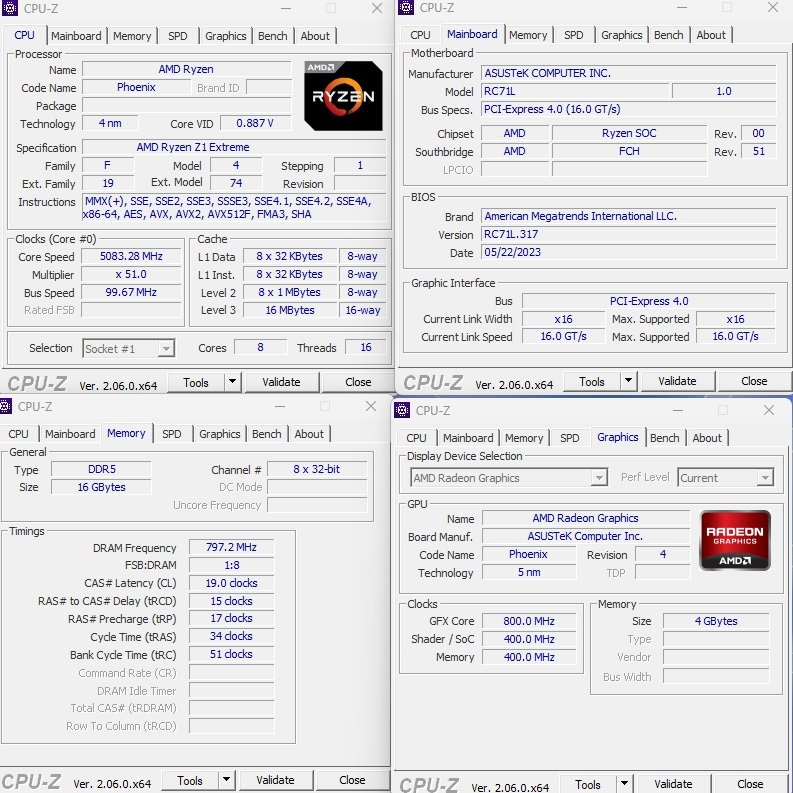 The graphics are managed by the chip’s RDNA3-based Radeon GPU, featuring 12 CUs and clock speeds reaching 2.7 GHz speeds and a computing power of 8.6 Teraflops. While our review sample comes with the Ryzen Z1 Extreme, ASUS will also be offering a lower variant that is powered by the 6-core Ryzen Z1 APU and a weaker RDNA 3 GPU with 4 CUs. The system also runs 16GB LPDDR5 memory that is clocked at 6400MHz speeds and the device runs on Windows 11 Home edition. While the default memory allotted as VRAM is 4GB, you can change the configuration and select up to 8GB via the Armoury Crate app.
The graphics are managed by the chip’s RDNA3-based Radeon GPU, featuring 12 CUs and clock speeds reaching 2.7 GHz speeds and a computing power of 8.6 Teraflops. While our review sample comes with the Ryzen Z1 Extreme, ASUS will also be offering a lower variant that is powered by the 6-core Ryzen Z1 APU and a weaker RDNA 3 GPU with 4 CUs. The system also runs 16GB LPDDR5 memory that is clocked at 6400MHz speeds and the device runs on Windows 11 Home edition. While the default memory allotted as VRAM is 4GB, you can change the configuration and select up to 8GB via the Armoury Crate app.
While I’m really impressed with the design and the chipset of the Ally, the one thing I was disappointed with was the type of SSD used. The ROG Ally comes with a Type 2230-based 512GB PCIe 4.0 NVMe SSD, the same kind that is used on the Steam Deck. The problem here is that there are very few storage options available for the Type 2230-based SSDs and the maximum capacity available is 2TB by reliable brands. I honestly wish ASUS just went for the standard Type 2280-based PCIe drives where you can upgrade your internal storage up to 8TB capacities. Most of the handheld brands offer gaming devices with slots for 2280-based PCIe 4 SSDs and I also plan to upgrade my Aya Neo 2 with a 4TB 2280 PCIe 4.0 SSD.
That said, there was the question of whether customers in the UAE will lose the product warranty if they decide to swap the internal SSD for a higher-capacity model. I had approached ASUS Middle East regarding the matter and their response was that users will not lose the warranty, provided that they do not cause any damage to other components. They also mentioned to me that the new SSD needs to be part of the ASUS QVL (Qualified Vendor List) where the company has officially verified that the drive works with ASUS ROG Ally. The Micron 2400 512GB 2230 SSD that comes with the ROG Ally has an impressive loading performance. And according to our CrystalDiskMark scores, the read speeds reached up to 4279MB/s and the write speeds up to 1818 MB/s.
Benchmarks
I tested most of the games and theoretical apps on both 25W battery-based Turbo mode and 30W plugged-in Turbo modes to see if there are performance differences. I also used my Aya Neo 2 for comparison. The device is powered by the Ryzen 7 6800U APU (Zen 3+ CPU cores and RDNA2 GPU cores) and 16GB LPDDR5 6400MHz RAM.
 We ran theoretical benchmarks such as CineBench R23 and Futuremark-based FireStrike, TimeSpy, Port Royal, and more. We also tested several games, some in both 1080p and 720p resolutions. I even ran some games with ray tracing enabled to see what the device is capable of. From the scores we achieved, the Ally performed very well at 25W (much better than the Aya Neo 2). The performance gains when using 30W Turbo mode are more beneficial for theoretical benchmarks rather than gaming.
We ran theoretical benchmarks such as CineBench R23 and Futuremark-based FireStrike, TimeSpy, Port Royal, and more. We also tested several games, some in both 1080p and 720p resolutions. I even ran some games with ray tracing enabled to see what the device is capable of. From the scores we achieved, the Ally performed very well at 25W (much better than the Aya Neo 2). The performance gains when using 30W Turbo mode are more beneficial for theoretical benchmarks rather than gaming.
With a mix of high or low graphical settings at 1080p and 720p resolutions, the ROG Ally is capable of easily achieving performance between 50fps and 80fps (depending on the game title). I also happen to use different modes of FSR on games such as CyberPunk and Forza 5 and we were able to notice performance improvements. While the handheld is easily capable of playing above 60fps, it may be a bit of a challenge to achieve 120fps for all PC games and take advantage of the 120Hz IPS display. For DOOM Eternal, I had to tune down the settings to 720p low presets to easily achieve an average of 129fps at 25W. Playing easy-to-run or older games should also help to push the framerates to 120 fps. We also ran games such as Halo Infinite at 1080p low presets and the game ran around 75fps on average. We also ran older GPU-taxing games such as Crysis 2 and Crysis 3, and the device performed similar results.
Battery
While the ROG Ally is currently the most powerful gaming handheld (as of the time of writing), the next challenge is the battery life of the device and how long the handheld can last during gaming. The ROG Ally houses a 40Whrs, 4S1P, 4-cell Li-ion battery and supports 65W USB-C charging. We ran a battery test of our own that include playing DOOM Eternal at 1080p low settings on the 25W Turbo mode, 15W Performance mode, and 9W Silent mode.
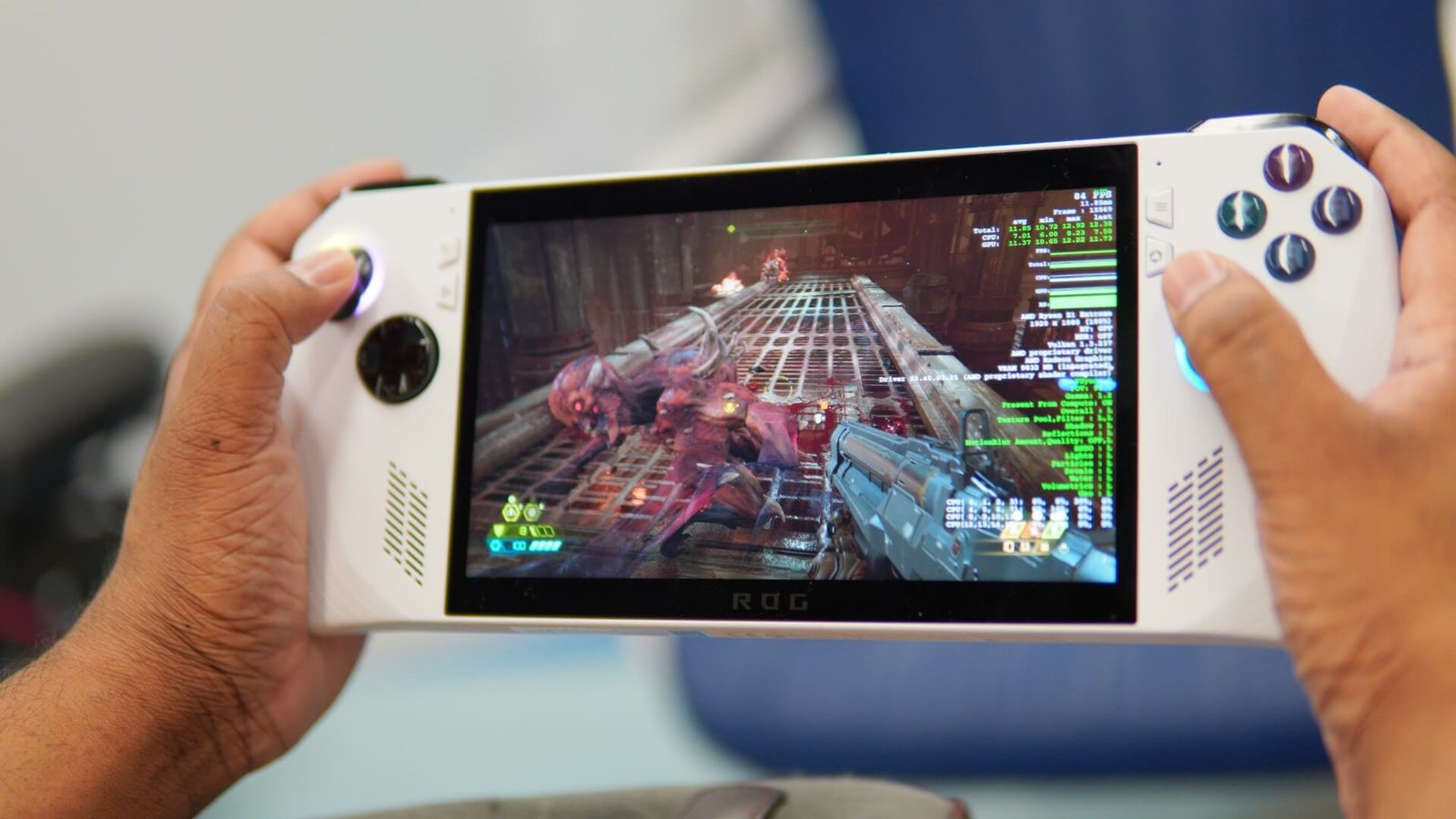
When playing from a full charge and with 25W mode selected, we were able to last about an hour of gameplay with an average of 85fps performance. We repeated the sequence again with the 15W Performance mode and the handheld lasted for one hour and 33 minutes of gameplay. What surprised me was the fact that even with the 15W mode selected, the game ran smoothly with an average performance of 62fps. However, playing the game at 9W silent mode dropped the framerates down to 25fps. I’m certain that the handheld can produce higher framerates and last almost the same when lowering the resolution to 720p.
Verdict
With the introduction of ASUS’s first Windows gaming handheld, it is apparent now that more PC brands will be inclined to grab a slice of the handheld market. Until then, the ASUS ROG Ally will remain as the best-performing gaming handheld. The device features a brilliant 7-inch FHD IPS panel that is capable of a 120Hz native refresh rate and supports AMD FreeSync Premium. The device weighs only 608g and feels light for comfortable gaming sessions. The buttons and the control layout are easy to reach and the portable PC also has a dedicated button to access the ASUS Command Center and Armoury Crate app. The device also holds a 3.5mm audio jack, a USB-C port for power, support for DisplayPort, and an interface for XG Mobile connectivity.
 The ROG Ally also comes with Hall-effect triggers and the textured grips on the rear side help for longer gaming sessions. The portable machine is powered by the latest AMD Ryzen Z1 Extreme APU that packs eight Zen4 CPU cores and RDNA3-based GPU with 12CUs, along with 16GB LPDDR5 6400MHz RAM. The 512GB 2230 SSD may come short of storage space but users can swap for a ASUS QVL-approved higher storage drive without losing warranty. The device also has a MicroSD card slot with support for UHS-II cards. While the 40Whrs 4-cell battery can last only for a few hours of gameplay, the included power adapter has support for 65W charging.
The ROG Ally also comes with Hall-effect triggers and the textured grips on the rear side help for longer gaming sessions. The portable machine is powered by the latest AMD Ryzen Z1 Extreme APU that packs eight Zen4 CPU cores and RDNA3-based GPU with 12CUs, along with 16GB LPDDR5 6400MHz RAM. The 512GB 2230 SSD may come short of storage space but users can swap for a ASUS QVL-approved higher storage drive without losing warranty. The device also has a MicroSD card slot with support for UHS-II cards. While the 40Whrs 4-cell battery can last only for a few hours of gameplay, the included power adapter has support for 65W charging.




